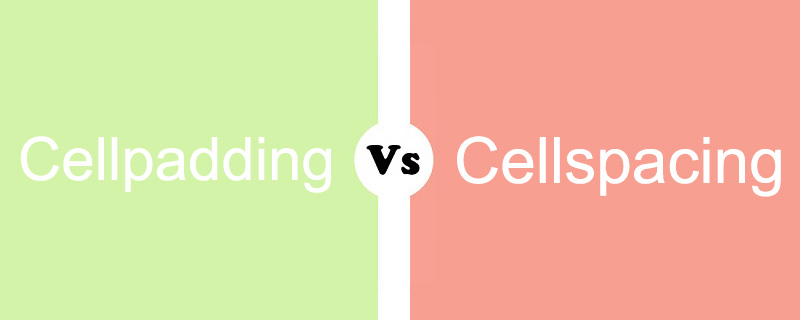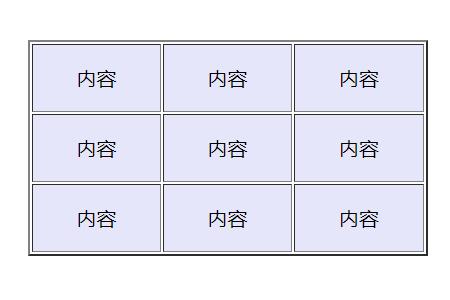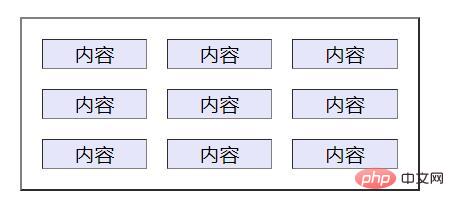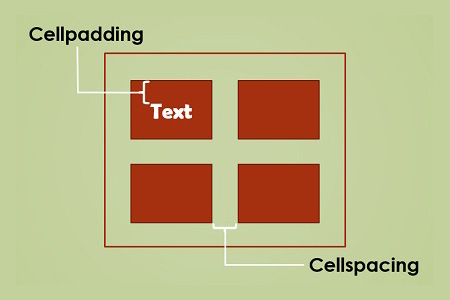Difference Between Cellpadding and Cellspacing
Cellpadding and Cellspacing are attributes used in table tables. They can set the blanks in table cells. They are two attributes that help control the style and layout of tables in web pages. So what's the difference between them? The following article will give you a brief comparison and introduce the differences between Cellpadding and Cellspacing. I hope it will be helpful to you.

Cellpadding Property
The property that sets the cell space between the content and the outer border is called cellpadding. In other words, the distance between the cell's surrounding content and the cell's borders is managed through the cellpadding property. The units for this distance can be implicit in HTML as pixels or percentages.
According to user needs, the cellpadding attribute value can also be 0. It is used to separate text from each other, thus improving the appearance.
Simple example:
<!DOCTYPE html>
<html>
<head>
<meta charset="UTF-8">
<title>Cellpadding属性的简单示例</title>
<style>
table{
font-size: 20px;
width: 100%;
text-align: center;
}
td {background-color:lavender;}
</style>
</head>
<body>
<table border = "2" cellpadding = "20">
<tbody>
<tr><td>内容</td><td>内容</td><td>内容</td></tr>
<tr><td>内容</td><td>内容</td><td>内容</td></tr>
<tr><td>内容</td><td>内容</td><td>内容</td></tr>
</tbody>
</table>
</body>
</html>Output:

##Note: Older versions of HTML support the cellpadding command, But later versions of HTML5 do not allow cellpadding, so alternative CSS is used to provide the same formatting when needed.
Cellspacing property
The Cellspacing property can control the distance between individual cells in the table. By using this property, designers can easily change the space between the edges of different adjacent cells. Cellspacing properties are mainly used in web design. Different languages have completely different syntax for cellspacing, for example using the "border-spacing" attribute in CSS and "cellspacing" in HTML.Simple example:
<!DOCTYPE html>
<html>
<head>
<meta charset="UTF-8">
<title>Cellspacing属性的简单示例</title>
<style>
table{
font-size: 20px;
width: 100%;
text-align: center;
}
td {background-color:lavender;}
</style>
</head>
<body>
<table border = "2" cellspacing = "20">
<tbody>
<tr><td>内容</td><td>内容</td><td>内容</td></tr>
<tr><td>内容</td><td>内容</td><td>内容</td></tr>
<tr><td>内容</td><td>内容</td><td>内容</td></tr>
</tbody>
</table>
</body>
</html>Output:

Summary:
The main difference between cellpadding and cellspacing is that cellpadding is used to fix the width between the edge of a cell and its content, That is, creating white space within the cell between the text and the cell border. However, cellspacing can be used to manage the space between individual cells in a table.
The above is the detailed content of Difference Between Cellpadding and Cellspacing. For more information, please follow other related articles on the PHP Chinese website!

Hot AI Tools

Undresser.AI Undress
AI-powered app for creating realistic nude photos

AI Clothes Remover
Online AI tool for removing clothes from photos.

Undress AI Tool
Undress images for free

Clothoff.io
AI clothes remover

Video Face Swap
Swap faces in any video effortlessly with our completely free AI face swap tool!

Hot Article

Hot Tools

Notepad++7.3.1
Easy-to-use and free code editor

SublimeText3 Chinese version
Chinese version, very easy to use

Zend Studio 13.0.1
Powerful PHP integrated development environment

Dreamweaver CS6
Visual web development tools

SublimeText3 Mac version
God-level code editing software (SublimeText3)

Hot Topics
 1664
1664
 14
14
 1423
1423
 52
52
 1318
1318
 25
25
 1269
1269
 29
29
 1248
1248
 24
24
 Understanding HTML, CSS, and JavaScript: A Beginner's Guide
Apr 12, 2025 am 12:02 AM
Understanding HTML, CSS, and JavaScript: A Beginner's Guide
Apr 12, 2025 am 12:02 AM
WebdevelopmentreliesonHTML,CSS,andJavaScript:1)HTMLstructurescontent,2)CSSstylesit,and3)JavaScriptaddsinteractivity,formingthebasisofmodernwebexperiences.
 HTML: The Structure, CSS: The Style, JavaScript: The Behavior
Apr 18, 2025 am 12:09 AM
HTML: The Structure, CSS: The Style, JavaScript: The Behavior
Apr 18, 2025 am 12:09 AM
The roles of HTML, CSS and JavaScript in web development are: 1. HTML defines the web page structure, 2. CSS controls the web page style, and 3. JavaScript adds dynamic behavior. Together, they build the framework, aesthetics and interactivity of modern websites.
 The Future of HTML, CSS, and JavaScript: Web Development Trends
Apr 19, 2025 am 12:02 AM
The Future of HTML, CSS, and JavaScript: Web Development Trends
Apr 19, 2025 am 12:02 AM
The future trends of HTML are semantics and web components, the future trends of CSS are CSS-in-JS and CSSHoudini, and the future trends of JavaScript are WebAssembly and Serverless. 1. HTML semantics improve accessibility and SEO effects, and Web components improve development efficiency, but attention should be paid to browser compatibility. 2. CSS-in-JS enhances style management flexibility but may increase file size. CSSHoudini allows direct operation of CSS rendering. 3.WebAssembly optimizes browser application performance but has a steep learning curve, and Serverless simplifies development but requires optimization of cold start problems.
 The Future of HTML: Evolution and Trends in Web Design
Apr 17, 2025 am 12:12 AM
The Future of HTML: Evolution and Trends in Web Design
Apr 17, 2025 am 12:12 AM
The future of HTML is full of infinite possibilities. 1) New features and standards will include more semantic tags and the popularity of WebComponents. 2) The web design trend will continue to develop towards responsive and accessible design. 3) Performance optimization will improve the user experience through responsive image loading and lazy loading technologies.
 HTML vs. CSS vs. JavaScript: A Comparative Overview
Apr 16, 2025 am 12:04 AM
HTML vs. CSS vs. JavaScript: A Comparative Overview
Apr 16, 2025 am 12:04 AM
The roles of HTML, CSS and JavaScript in web development are: HTML is responsible for content structure, CSS is responsible for style, and JavaScript is responsible for dynamic behavior. 1. HTML defines the web page structure and content through tags to ensure semantics. 2. CSS controls the web page style through selectors and attributes to make it beautiful and easy to read. 3. JavaScript controls web page behavior through scripts to achieve dynamic and interactive functions.
 HTML: Building the Structure of Web Pages
Apr 14, 2025 am 12:14 AM
HTML: Building the Structure of Web Pages
Apr 14, 2025 am 12:14 AM
HTML is the cornerstone of building web page structure. 1. HTML defines the content structure and semantics, and uses, etc. tags. 2. Provide semantic markers, such as, etc., to improve SEO effect. 3. To realize user interaction through tags, pay attention to form verification. 4. Use advanced elements such as, combined with JavaScript to achieve dynamic effects. 5. Common errors include unclosed labels and unquoted attribute values, and verification tools are required. 6. Optimization strategies include reducing HTTP requests, compressing HTML, using semantic tags, etc.
 The Role of HTML: Structuring Web Content
Apr 11, 2025 am 12:12 AM
The Role of HTML: Structuring Web Content
Apr 11, 2025 am 12:12 AM
The role of HTML is to define the structure and content of a web page through tags and attributes. 1. HTML organizes content through tags such as , making it easy to read and understand. 2. Use semantic tags such as, etc. to enhance accessibility and SEO. 3. Optimizing HTML code can improve web page loading speed and user experience.
 HTML: Is It a Programming Language or Something Else?
Apr 15, 2025 am 12:13 AM
HTML: Is It a Programming Language or Something Else?
Apr 15, 2025 am 12:13 AM
HTMLisnotaprogramminglanguage;itisamarkuplanguage.1)HTMLstructuresandformatswebcontentusingtags.2)ItworkswithCSSforstylingandJavaScriptforinteractivity,enhancingwebdevelopment.




